
This is first Earthcache in Zagreb, hope that you will like it as
much as I doo.
Visit to Veternica cave...

How to reach Veternica Cave?
Public
transportation
Take the ZET bus for Gornji Stenjevac,
bus line no. 124 from the terminal at Crnomerec (takes about 15
min.). Access (hiking) trail no. 3 to the cave goes along the
valley of Dubravica stream, and the hike takes about 15-20 min.
Bus schedule:
www.zet.hr
By car
Take the car to Bologna Avenue to the
west, and after Gajnice (immediately after gas station) make a
right turn in Dubravica Street . If you want to reach Veternica
from the bottom access trail, from Gornji Stenjevec, continue
driving along Dubravica Street (on the second crossroad turn left)
to the end of the road. If you plan to reach climbers' lodging
“Glavica”, you have to make a right turn on the second crossroad to
Zelena magistrala and drive to the end of asphalt road and parking
place at Ponikve meadow.
In a 30 minute walk (hiking trails 8 and
1M) from Ponikve you will reach climbers' lodging "Glavica", from
there downhill along hiking trail no. 3, and in 5 minutes you will
come to the cave.
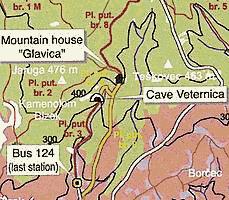
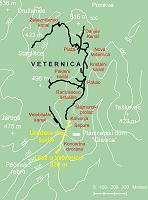
How to reach Veternica cave? Veternica cave map
Geology
Why was Veternica cave formed exactly in this part of
Medvednica?
Southwestern part of Medvednica is a karst area, and in that way it
reminds of southern Dinaric region of Croatia . Like other karst
regions this area is built of limestone and limestone similar rock
called dolomites. Water easily dissolves these rocks and causes the
formation of different surface and underground karst shapes.
Veternica cave was formed during Pleistocene, which begun 1.8
million years ago, and ended about 10.000 years ago. In the
Pleistocene era glacial and interglacial periods exchanged.
Veternica cave was formed by water sinking in Ponikve area along
the rock fissures in the northwest – southeast direction. Water has
found the easiest path in the underground, and has flown on the
contact of two types of rocks: lithothamnium limestone and
dolomites underneath it. Porous lithothamnium limestone can be seen
on the ceiling of the cave. In its formation during the geological
period called Miocene (about 16 million years ago), red algae
Lithothamnium had an important role. In it we can notice
fossilized tubers of algae, shells and residues of sea urchins (for
example genus Clypeaster - *SOUVENIR) , and shark teeth
were found as well. Grey dolomite, which is placed underneath it,
has been settling in shallow sea of the Triassic period (about 225
to 195 million years ago).
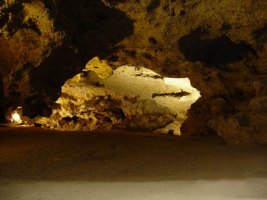 Veternica - passage
Veternica - passage
Cave ornaments
Underground water on karst locations is “hard” because of the
dissolved limestone. By extracting the dissolved limestone through
evaporation, and other reasons, “cave ornaments” - dripstones
(curtains, etc.) form. Dripstones differ from each other by their
form and origin. In Veternica we find stalagmites, stalactites,
curtains, helictites, spaghetti (numerous thin stalactites which
represent the beginning stage of stalactites) and many others.
Average growth rate is 1 to 2 mm annuall
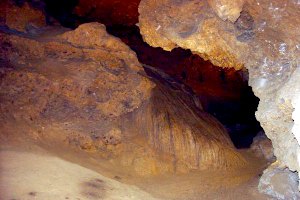 Veternica - stone waterfall
Veternica - stone waterfall
Paleontology
The surrounding inhabitants have always known the entrance to
the Veternica cave. Our geologist D. Gorjanovic-Kramberger mentions
it for the first time in 1899 in his paper.
Paleontology researches in Veternica cave were conducted on a
couple of occasions since 1950's. Academician Mirko Malez led the
diggings. Numerous findings that were dug from the sediment,
analyzed and scientifically processed, resounded in scientific
world and placed Veternica cave as one of important paleontology
sites in this part of Europe.
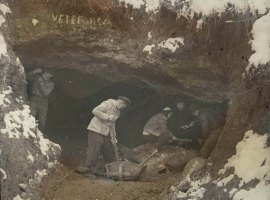 Researches
Researches
Layers are divided into two parts:
The upper layer settled during Holocene. It begun about 10
thousand years ago and lasts until today. The findings from this
layer belong to a period of early Stone Age, Bronze and Iron Age
and the Roman period. Roman emperors', Valentine II, Gracian, and
Theodosius I, money dating 4 th century B.C., oil-lamp and bronze
clasp for buttoning clothes – fibula, were found here. Tomb from
early Stone Age that consisted of uneven stone blocks laid in the
shape of half circle was discovered here as well. Human bones (
Homo sapiens sapiens sculls) , spear made of deer horn,
various ceramics and ornaments were found, too.
Beneath these are older layers that were formed during the last
glacial period during the younger Pleistocene (period of geological
past which begun 150 thousand years ago and finished about 10
thousand years ago). These layers the most abundant are findings of
cave bear, and they constitute nine tenths of all findings in
Veternica. Some of bear sculls, found in the front part of the
cave, were “immured” in rock niches and pointing in the same
direction. These findings indicate that the people that used to
live in Veternica probably worshiped the cult of the bear. In the
entrance of the cave we can see “bear grindings”. Those are the
rocks that were polished by cave bear scratching. Besides cave bear
findings there are numerous residue findings of other animals which
lived in these parts at that time: cave lion, wolf, various deer's,
rhinoceros, rodents, and many other animals.
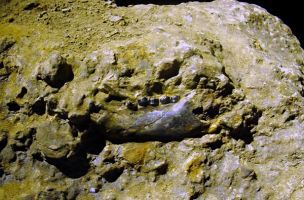
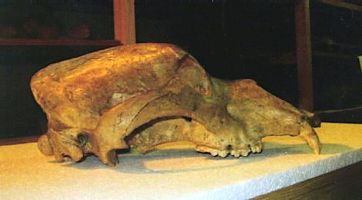
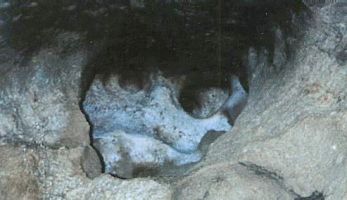
1. yaw (cave bear yaw, can be seen in the cave) 2. scull (cave bear
scull, HAZU) 3. scull - cult (rock niches with "imkmured" cave bear
scull)
Besides animal bones different tools (SOUVENIR!) of
Neanderthals (Homo sapiens neanderthalensis) were
found as well, which prove the cave was used by many hunters as a
shelter and home. In Neanderthal culture (Mousterian culture) the
most typical handicrafts were quartz spires, scrapers, daggers and
other stone and bone tools. They were used for wood or leather
treatment, cutting meat, or in hunt.
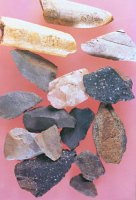 Tools from Veternica
Tools from Veternica
(Photo from booklet “Zagreb before Zagreb”, 1994. Zagreb city
museum)
Traces of burning fire and burned animal bones were found as
well. It is assumed that early man often settled Veternica cave.
However, at one point in time the entrance caved in, and it was
almost completely covered up. Since than, people stopped living in
it and just dwelled occasionally while bear hunting.
Most findings from Veternica cave are currently deposited in the
Institute for Quarter geology and palaeontology of Croatian Academy
of Science and Art
http://www.hazu.hr/Zpal-geo.html.
Life in Veternica
At the first glance most visitors of Veternica might think life
in these conditions is not possible – darkness, bare sharp rocks,
little nutrients … However, observing through eyes of bio-cavers,
besides bats we can find many different organisms adapted to
underground life. Which are the adaptations? Loss of pigment,
wings, eyes, decreased metabolism and the need for food, and
development of touch and smell are just a few adaptations of these
animals.
 Where do they
live?
Where do they
live?
Cave organisms have two basic habitats: aquatic and terrestrial.
Water is one of the most important factors in underground habitats.
In Veternica, in channels behind tourist part there are 15 water
streams that originate from a wider catchment area of southwest
part of Medvednica. Although rich with streams, it does not abound
with water fauna in the same degree. Until now determined are
crayfish Niphargus stygius likanus, and leech from genus
Trocheta.
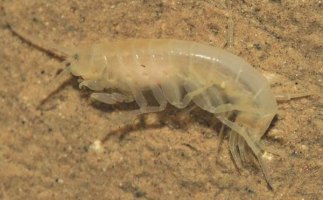
Crayfish, Niphargus stygius likanus
Terrestrial fauna dominates in species and abundance, as well as
exceptional number of endemic species. Some species never exit the
cave, they are born, live and die here
(Troglobiontes) for example Coleoptera
Anophtalmus kaufmanni weingärtneri , endemic subspecies in
Medvednica's underground.
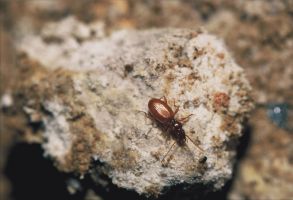
Coleoptera, Anophtalmus kaufmanni weingärtneri
Other species occasionally exit to the surface
(Troglophiles) – for example bats, and some
butterflies. On remains of timber myceliums of fungi genus Coprinus
occur.


Greater
Horseshoe Bat, Rhinolophus
ferrumequinum Butterflies,
Scoliopteryx libatrix
Butterflies,
Scoliopteryx libatrix
The ones that accidentally wander into the underground are
called Trogloxenes.
Cave ornaments
Underground water on karst locations is “hard” because of the
dissolved limestone. By extracting the dissolved limestone through
evaporation, and other reasons, “cave ornaments” - dripstones
(curtains, etc.) form. Dripstones differ from each other by their
form and origin. In Veternica we find stalagmites, stalactites,
curtains, helictites, spaghetti (numerous thin stalactites which
represent the beginning stage of stalactites) and many others.
Average growth rate is 1 to 2 mm annuall
Cave ornaments
Underground water on karst locations is “hard” because of the
dissolved limestone. By extracting the dissolved limestone through
evaporation, and other reasons, “cave ornaments” - dripstones
(curtains, etc.) form. Dripstones differ from each other by their
form and origin. In Veternica we find stalagmites, stalactites,
curtains, helictites, spaghetti (numerous thin stalactites which
represent the beginning stage of stalactites) and many others.
Average growth rate is 1 to 2 mm annuall
Geological
background
Veternica cave is located in southwest part of Medvednica, above
village Gornji Stenjevec. The distance from the center of Zagreb is
less than 9 km.
It is protected as a geomorphologic monument of nature since
1979.
It was named after the wind flow that appears at the entrance as a
result of temperature difference of the air (cave adiabatic is
about 10° C). Entrance to the cave is on elevation 320 m.
 Veternica - a view from the
inside
Veternica - a view from the
inside
Since 1950's Zagreb 's cavers have continuously been exploring the
cave and drawing maps of the underground corridors. Total length up
to now explored passages is 7104 m, and the length of the main
passage is 2622 m. Total altitude difference is over 200 m.
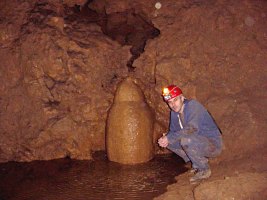 Veternica - caver
Veternica - caver
What can you see in the
cave?
Since 1979 Veternica cave is protected
by law as geomorphologic monument of nature.
The elevation of the cave entrance is
320 m. Total length of explored canals is 7128 m, and the length of
the main canal is 2622 m. The first 380 m of the cave are adapted
for visitors.

Veternica is in length the fifth cave in
Croatia, and the longest in northern Croatia. It is an important
archeological and paleontological site, and an enlightening example
of karst phenomenon. In 1889 Dragutin Gorjanovic Kramberger
attracts public attention to this cave.
The part of Veternica adapted for
tourists shows geomorphologic phenomenon rarely seen in classically
tourist adapted caves: oval erosion forms made by water vortexes,
which tell us about former water stream, sand dunes left after the
last underground stream which used to spring from Veternica,
extinct cave bear's ( Ursus speleus ) lower jaw, fossil
mud, the Well of wishes in Concert hall, fossil of a shell from
genus Pecten , sea-urchin Clypeaster on the
ceiling, Stone waterfall (a beautiful dripstone formation) etc.
Fourteen species of bats hibernate in the whole cave.
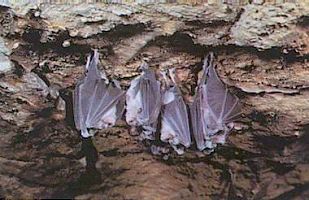
It is possible to visit Veternica with
an expert guide (45 to 60 minutes tour):
Work days – for
organized groups, in agreement with the Institution (on below
stated phone numbers). Maximum number of visitors in one group can
be 30.
Saturdays / Sundays –
from April until November with expert guidance from 10:00am to
16:00pm. Last entrance at 15:30. If it's raining the cave is
closed.
ADVICE FOR VISITORS:
The whole year round the temperature in
the cave is about 10 o C/50 F, for which reason during the warmer
part of the year it is necessary to bring warmer clothes. Also,
sports shoes are recommended because the approach trail to the cave
is possible only along hiking trails through the woods, and in the
cave in some parts there is mud.
Ticket price
- children 15 kn
- students and seniors 20 kn
- adults 25 kn
- family 50 kn
The cave cannot be visited without a
guide authorized by Public Institution “Nature Park Medvednica”.
Expert guidance is included in the price of the ticket.
Brochure «Veternica
cave» 5 kn
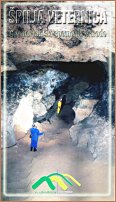
Tourist map Nature Park Medvednica 40 kn
Souvenirs
Veternica cave - bat pendant 12 kn
Neanderthals tool 15 kn
Sea-urchin Clypeaster cast 15 kn
Female T-shirt with picture of bat 80 kn
Male T-shirt with picture of bat 90 kn
For all further information feel free to
contact Public Institution “Nature Park Medvednica”:
Phone: +385 1 4586-317
Fax: +385 1
4586-318
e-mail:
park.prirode.medvednica@zg.htnet.hr
Your task:
1. Take a
picture of yourself (with GPS) at the Front of Veternica
Cave.
2. Answer following questions
and send me an email. If the answers are correct, you get a
permision to log. After logging as found, place the picture in your
log.
a) What is called era in which Veternica cave was formed?
b) Entrance in the cave is on which earth side?
Logs and E-Mail only in
english or Croatian